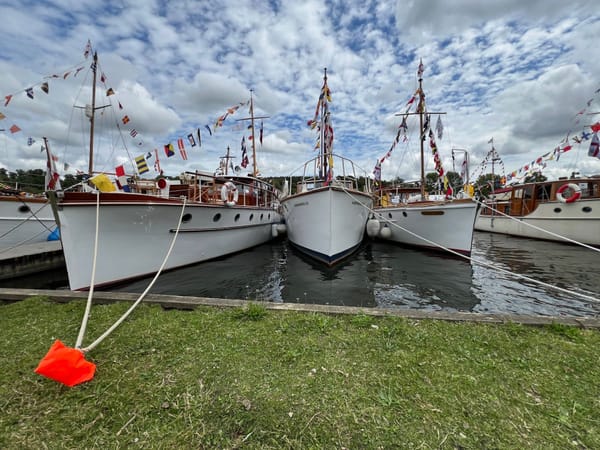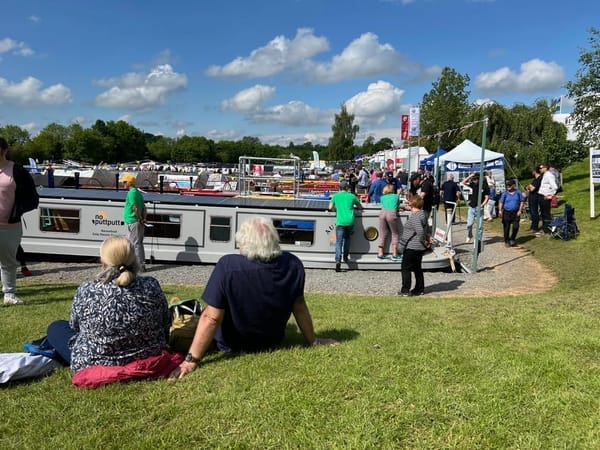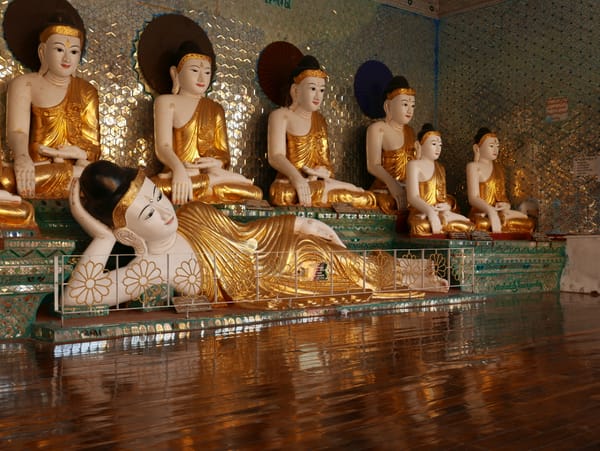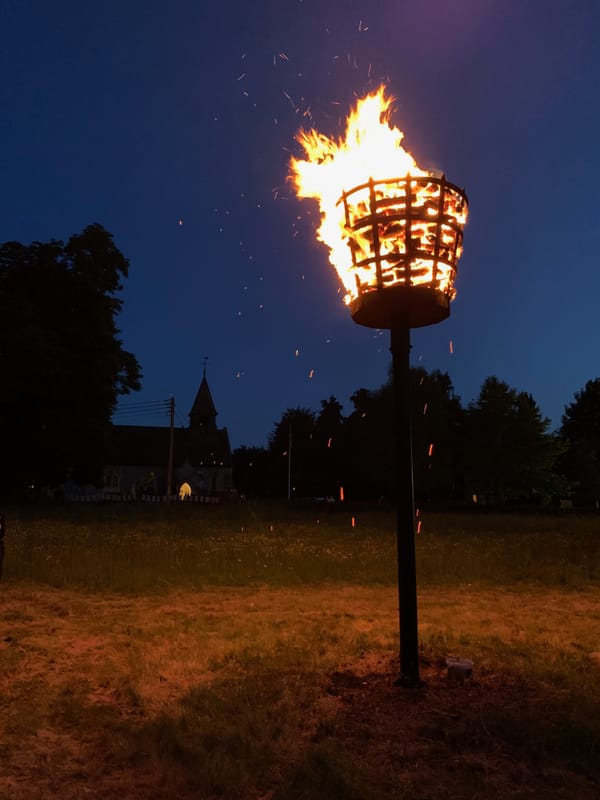Thailand — The Bridge on the River Kwai (สะพานข้ามแม่น้ำแคว), Maenam Khwae Rd., Mueang Kanchanaburi, Changwat Kanchanaburi 71000, Thailand
The bridge that doesn’t exist
September 2015
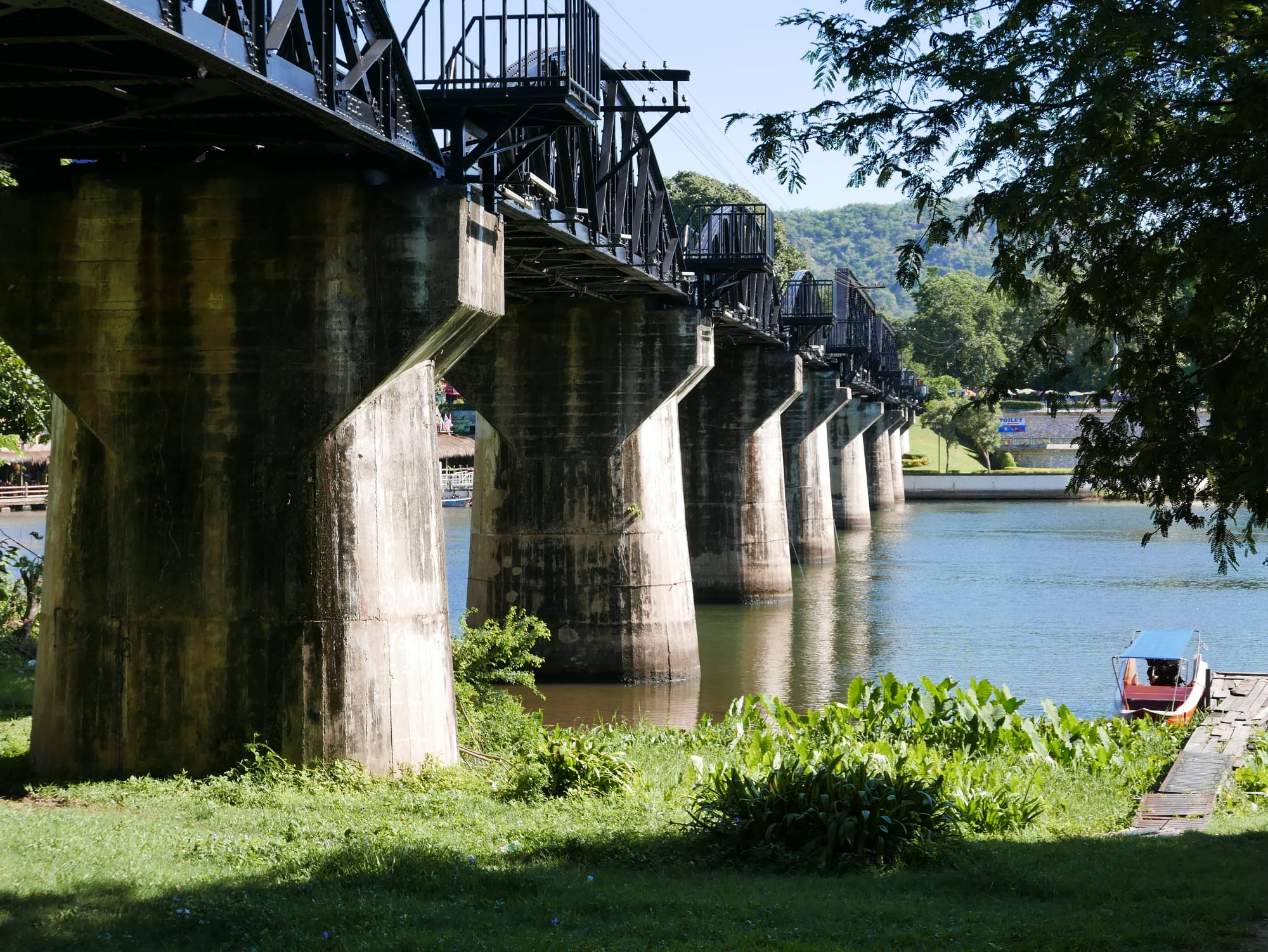
As a child, I remember watching a film called “The Bridge on the River Kwai” in which the wonderful Sir Alec Guinness (yes, that Alec Guinness — Obi-Wan Kenobi in the original Star Wars trilogy) plays the senior officer in a British Prisoner of War Camp in Thailand. The film was based on a book of the same name written by Pierre Boulle.
In the film, the Japanese force the Prisoners of War to build a bridge over the River Kwai. Alec Guinness’s character (Colonel Nicholson) collaborates with the Japanese and gets his men to assist in building the bridge. He does this for the right reasons — so his men can survive. Spoiler alert — Alec Guinness’s character realises his mistake at the film’s end with a brilliantly delivered, simple line of “What have I done?”. You can see the closing moments of the movie on YouTube.
So, I was in Thailand, looking for a Bridge on the River Kwai, and I had a problem.
There is no River Kwai — hence there cannot be a bridge.
There is a River Khwae Yai, but it was the Mae Klong River until the 1960s and during the Second World War. The film came out in 1957, and in the 1960s, the Thai Government renamed the river.
If you go to Wikipedia, you can read more about the film The Bridge on the River Kwai, the book The Bridge over the River Kwai, the Mae Klong River and the Khwae Yai River.
Anyway, I finally found The Bridge on the Khwae Yai River, or should that be The Bridge on the Mae Klong River?
At the bridge, there is a large black marble information plaque which, in gold letters, gives the story of the bridge (full text at the end of the post). The text states the Japanese army built the bridge during World War II as part of a strategic railway from Thailand to Burma (aka “The Death Railway”). Prisoners of War were forced to build the railway under challenging conditions due to the jungle, mountains, and dangerous animals. Ban Thamakham was chosen for the bridge site due to favourable geology.
On 16th September 1942, the Japanese army signed a contract with the Thai Government to build a railway from Thailand to Burma (now Myanmar).
British, Australian, and Dutch Prisoners of War and Chinese, Vietnamese, Indian, Burmese, and Javanese labourers constructed the railway. In total, around 200,000 people worked on the construction of the railway. Over 50% of the workforce died during the building of the railway, hence why it is called “The Death Railway”.
Construction of “The Bridge on the River Kwai (สะพานข้ามแม่น้ำแคว)” started in October 1942 with a temporary wooden bridge for the transport of construction materials. Floods swept this bridge away, and it had to be rebuilt. It took three months to complete construction, and the bridge was later removed as it obstructed river traffic.
While the wooden bridge was being built, work started on the main railway bridge.
The railway bridge had 11 semicircular steel spans supported on concrete piers. A wooden approach to the bridge gave a total length of 378 metres. Amazingly, only nine Prisoners of War were died in accidents during the bridge’s construction. And much of this was because of the “sensible and courageous leadership of the work camp’s British commanding officer, Lieutenant Colonel Philip Toosey” — an unsung hero of the Second World War.
The bridge was completed in May 1943, and the railway opened on 28th November 1943. The total length of the railway was 415 kilometres, with 304 km in Thailand and 111 in Burma (now Myanmar)
Allied planes bombed the bridge during the war, damaging spans 4–6.
After the war, the British government sold the railway to the Thai Government and the State Railway of Thailand. As part of war reparations from Japan, they repaired the bridge and replaced the damaged iron spans. The original iron spans had a curved top, and the replaced spans have a flat top. The wooden parts were also replaced with modern iron spans.
The bridge is still used by trains, and you can walk over it — watch out for the trains.
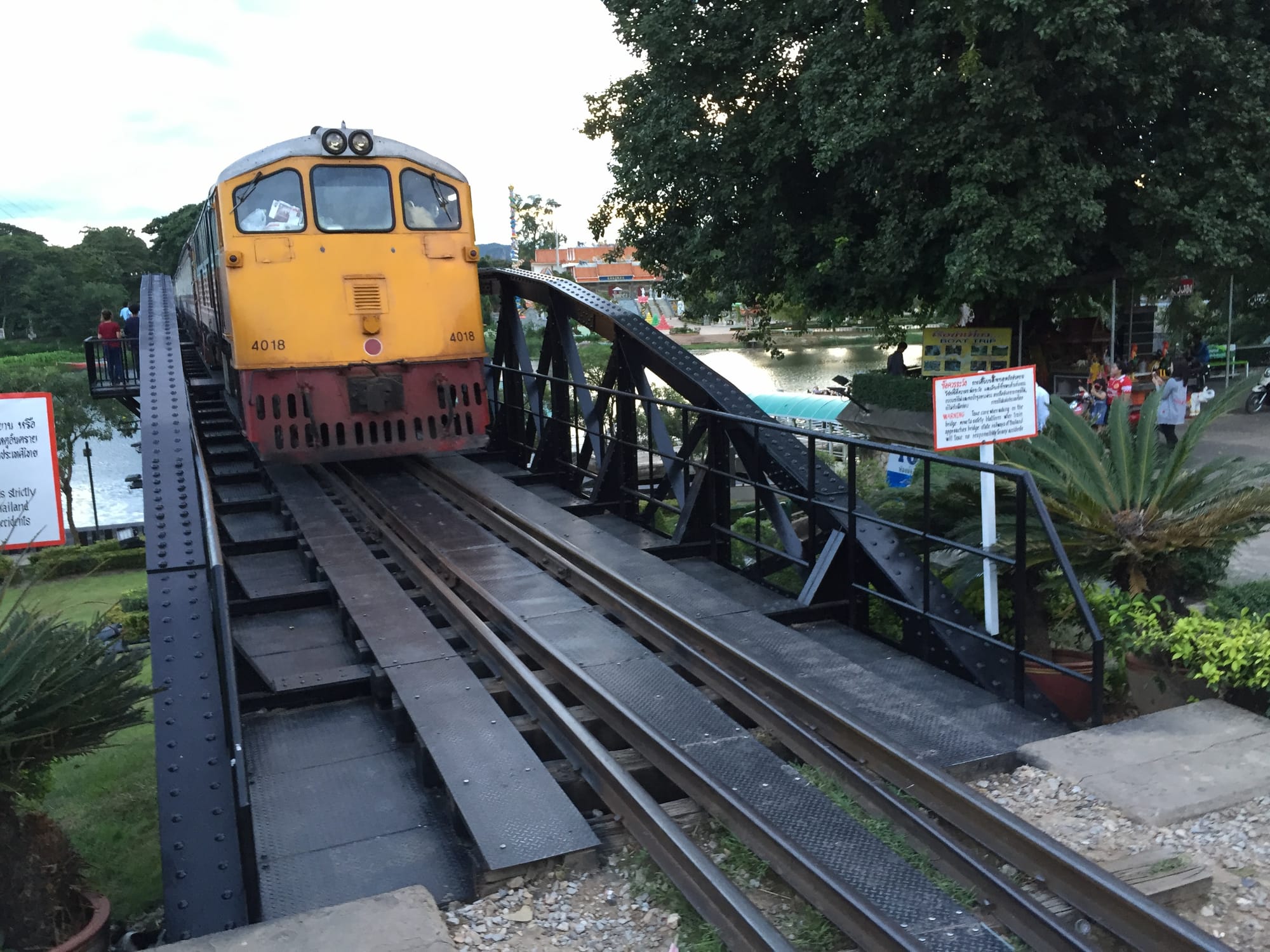
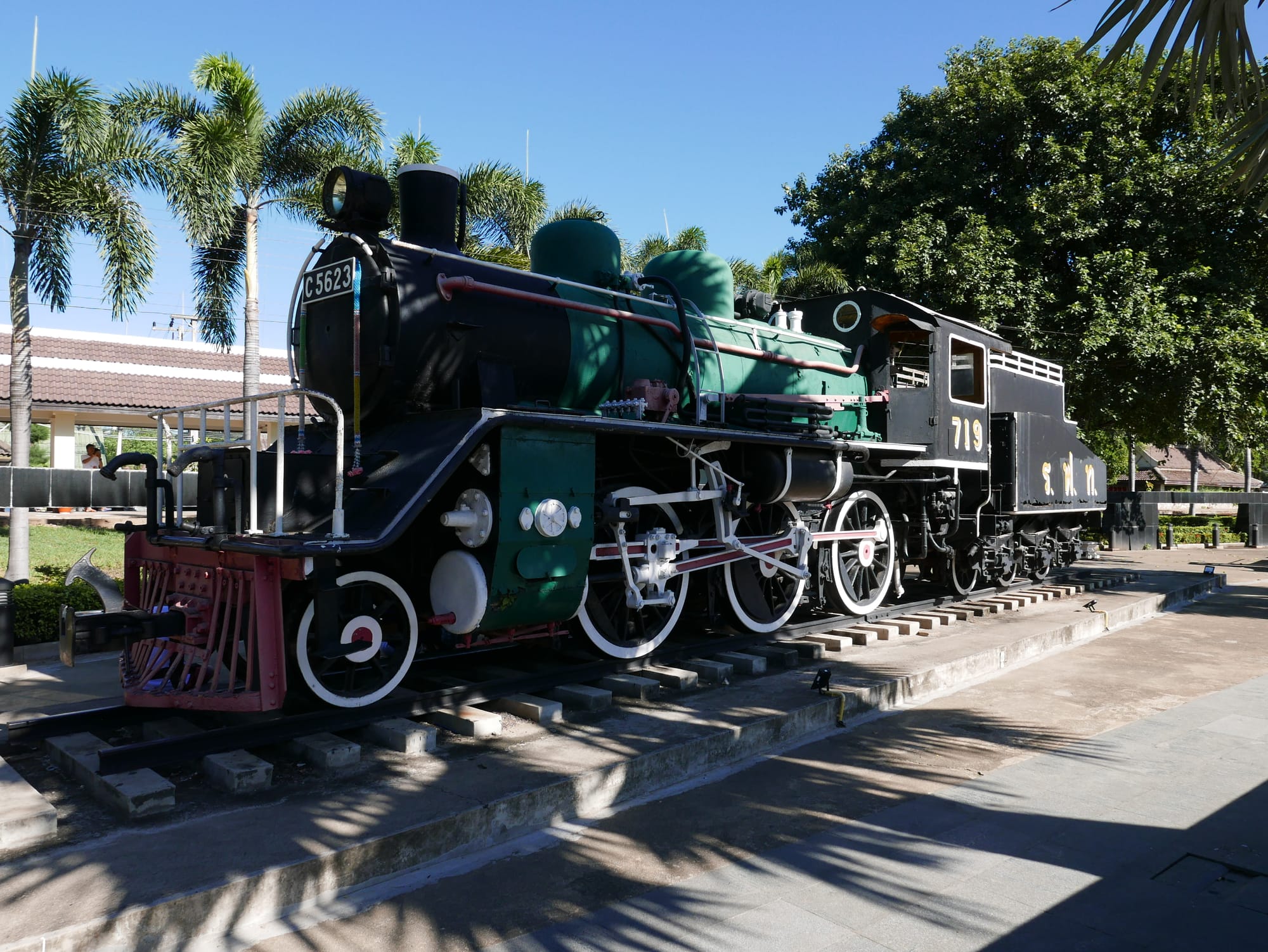
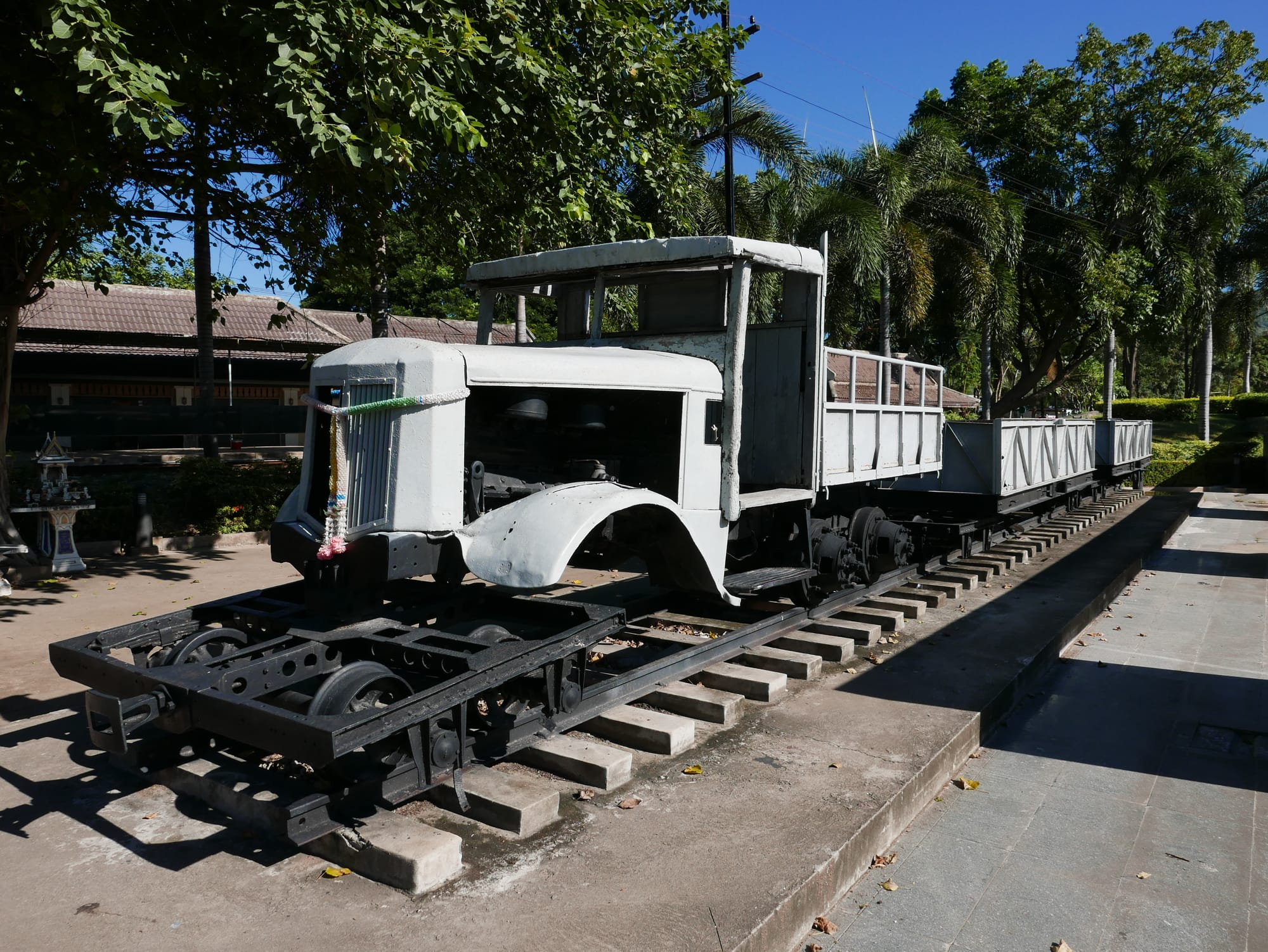
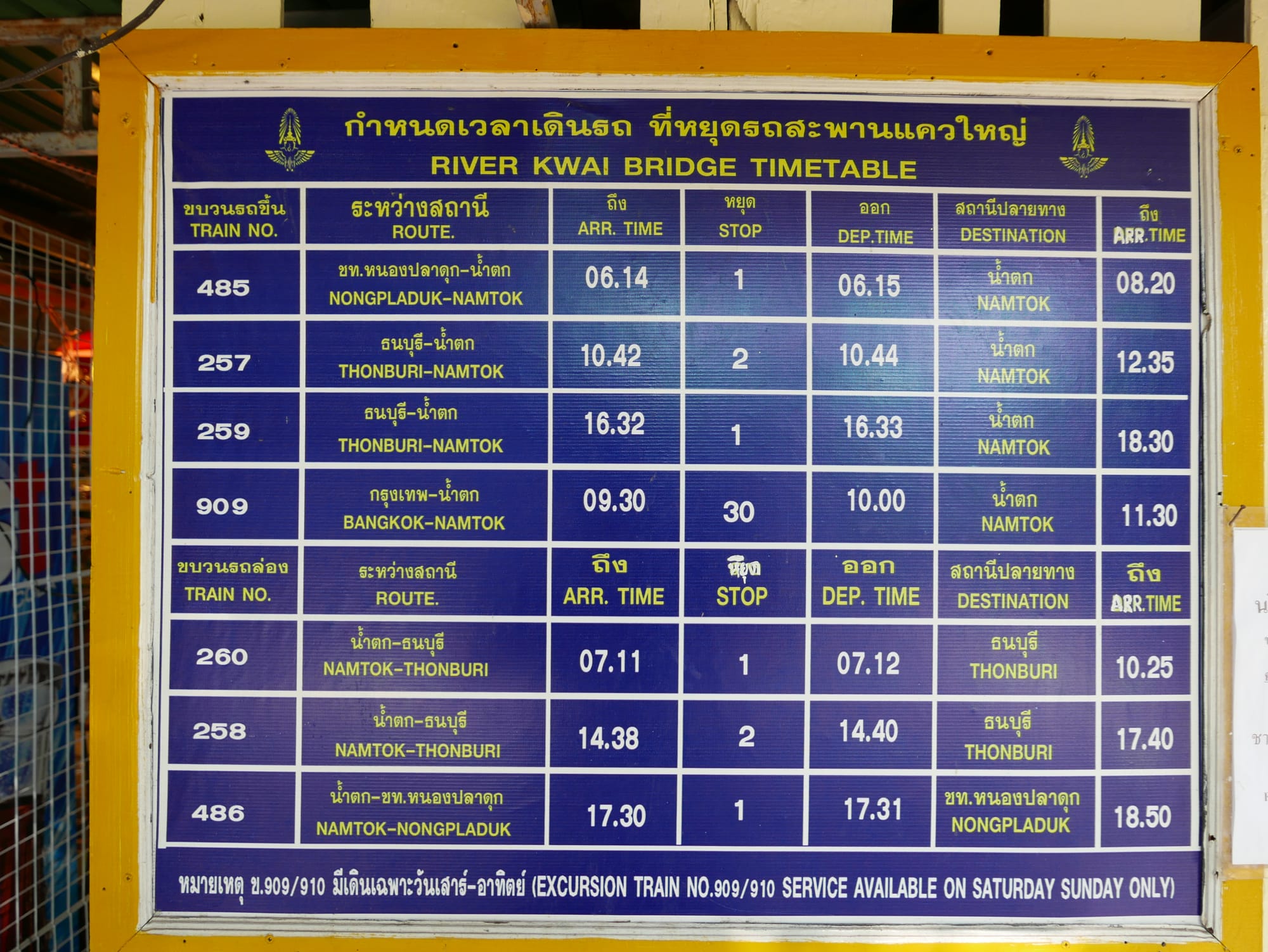
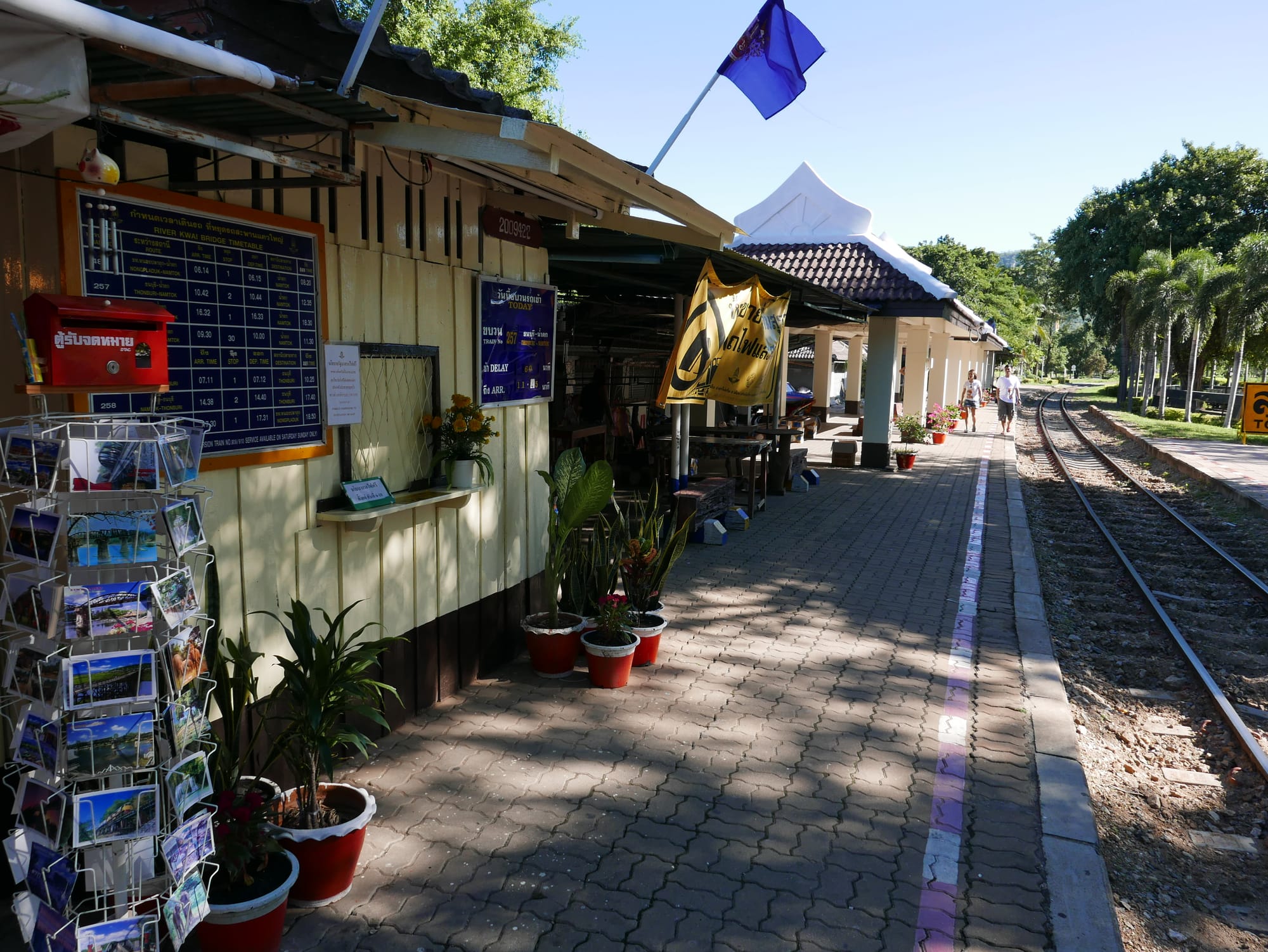
From the station, you can walk down to the bridge.
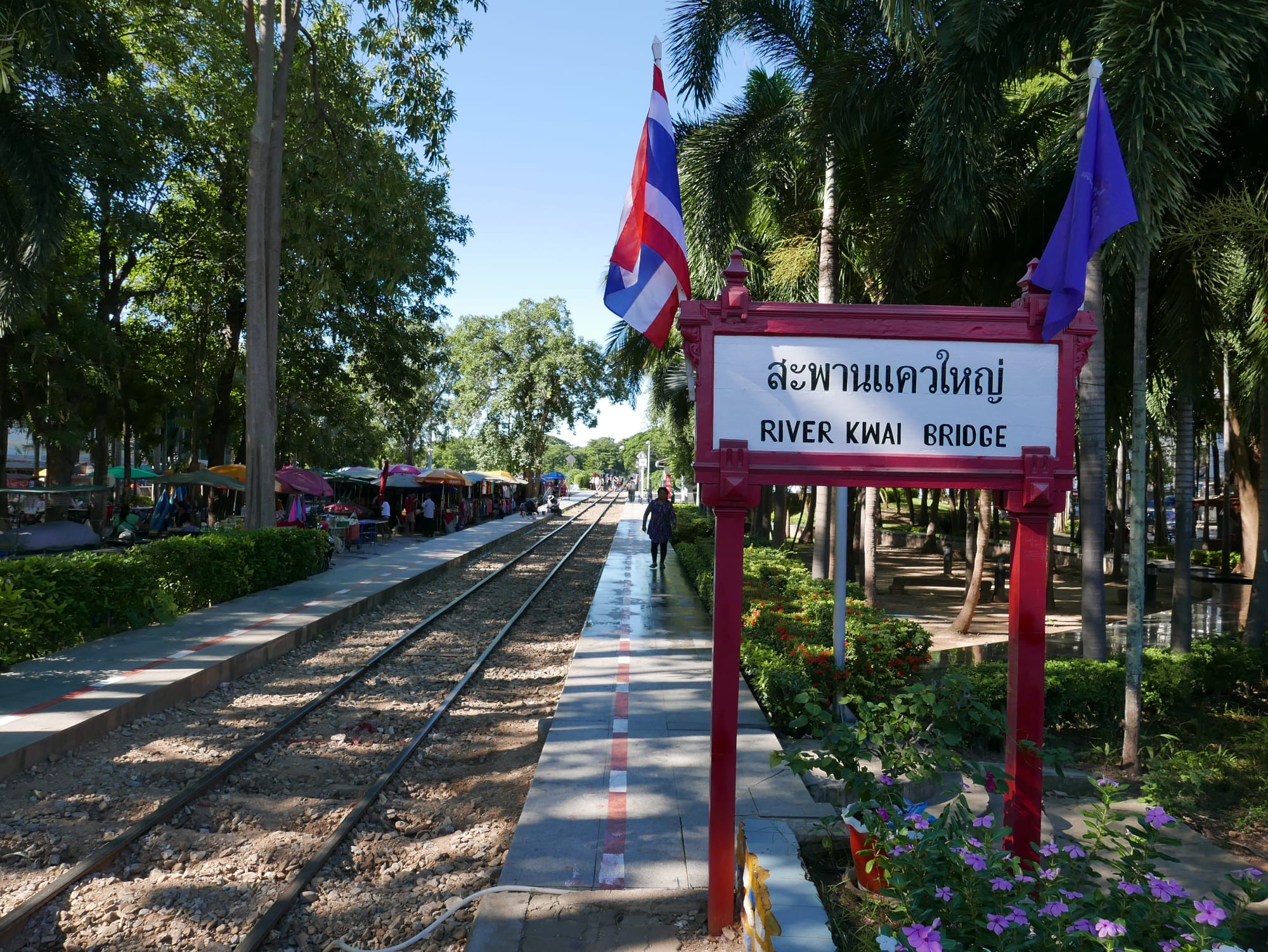
And you can walk across the bridge — note the warning signs that it is your responsibility to get out of the way when a train approaches.
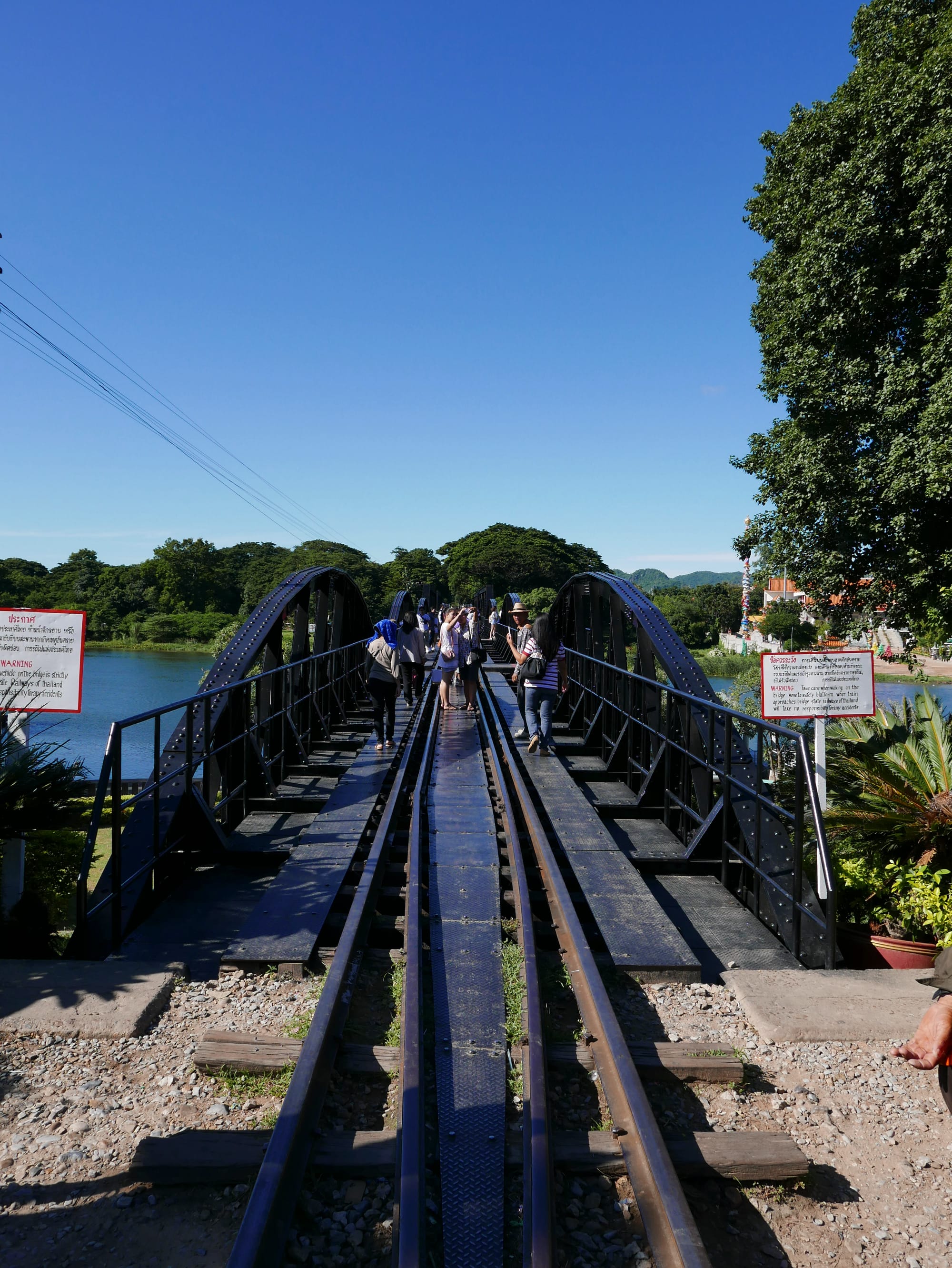
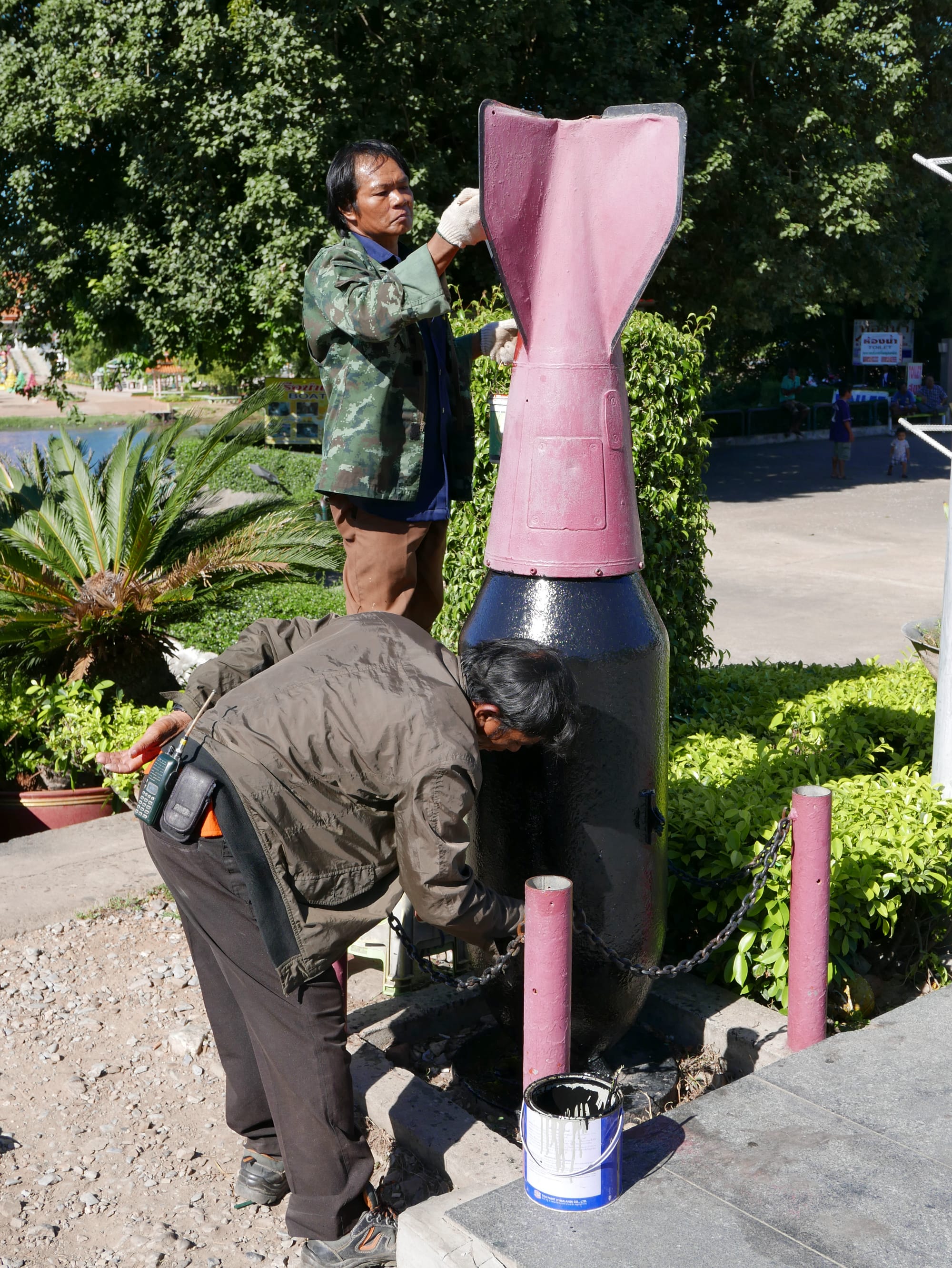
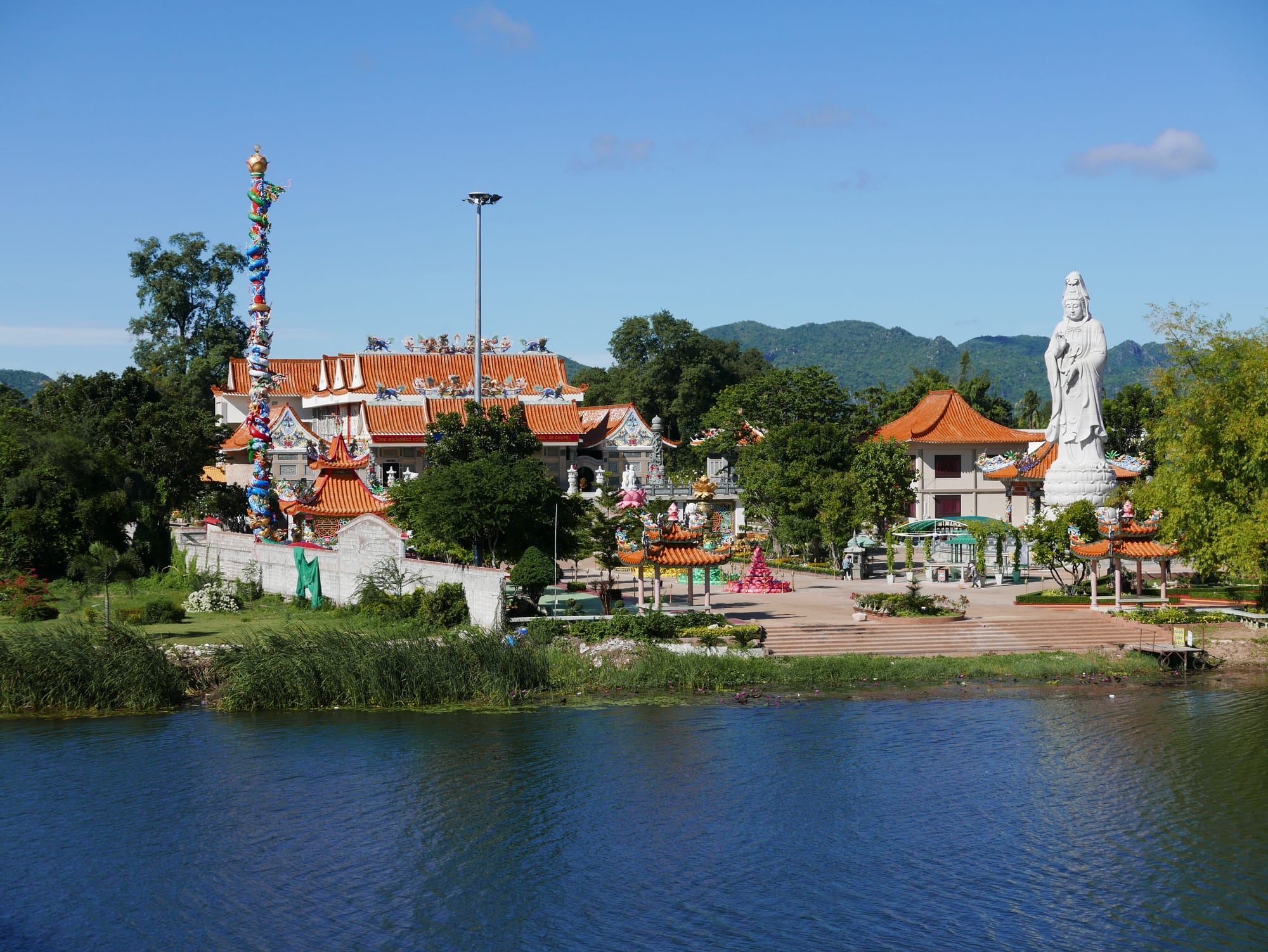
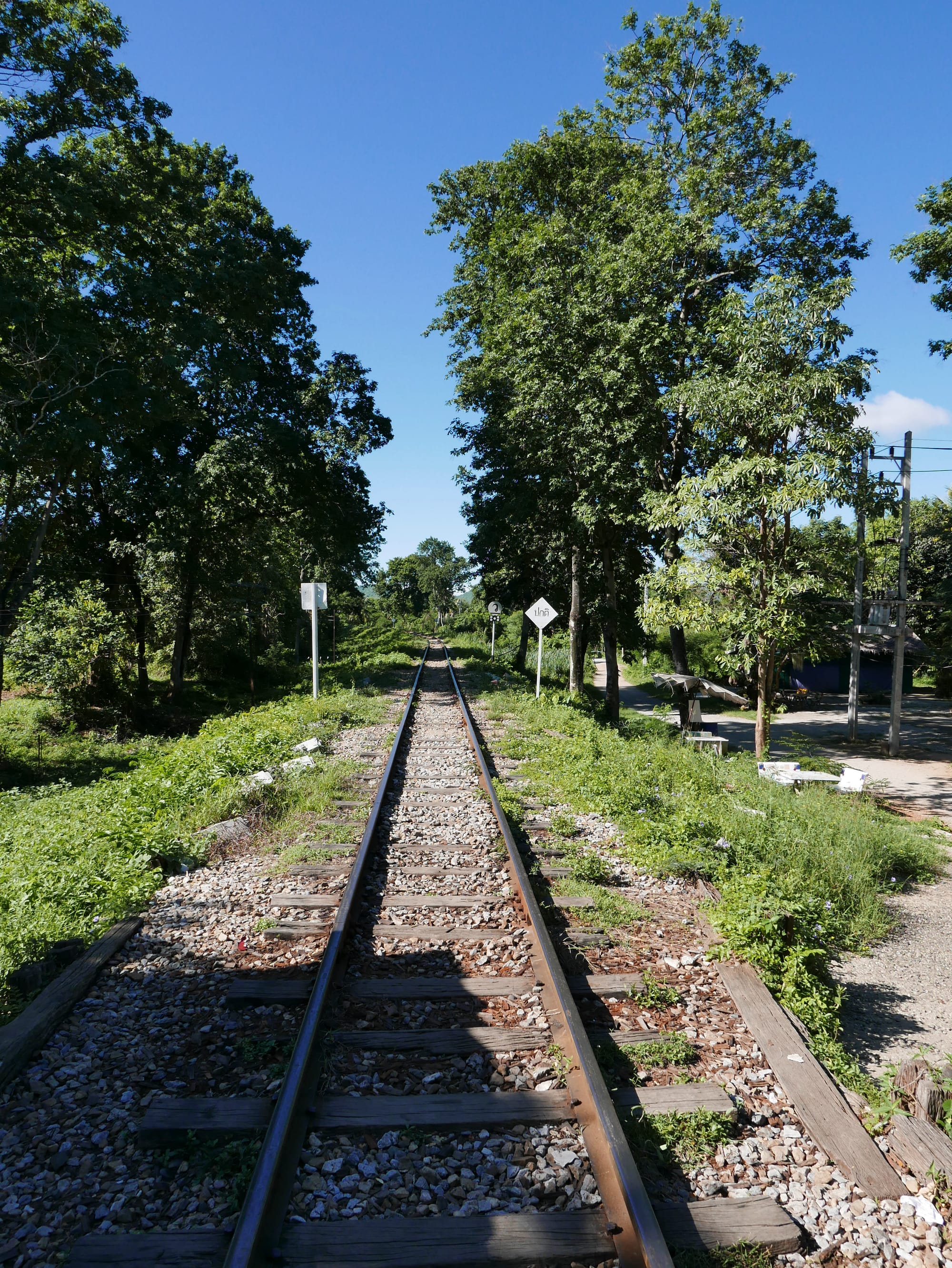
Originally, the track below was on a wooden approach ramp, but this was replaced after the war.
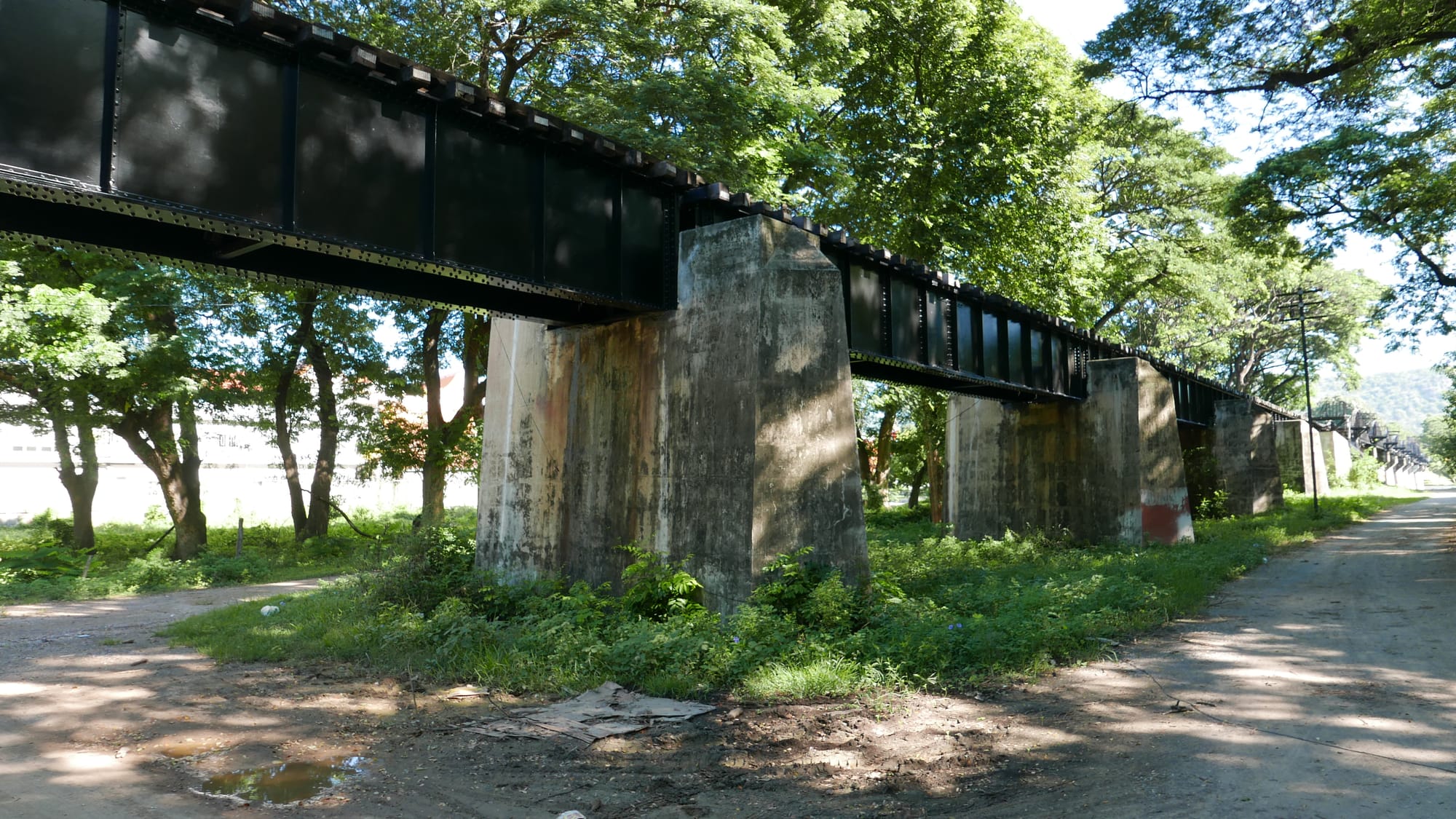
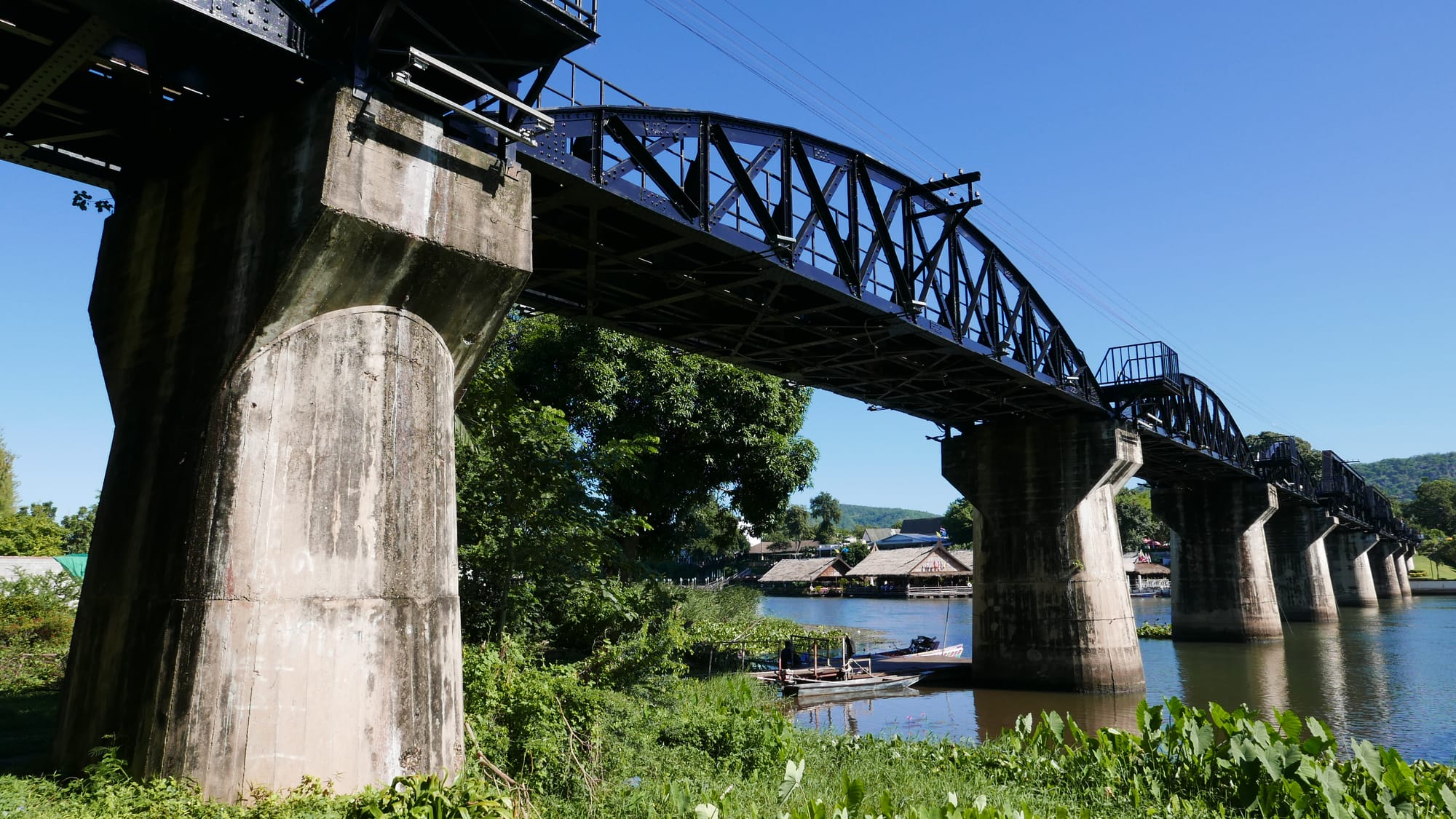
The Chinese Soldier Monument is on the far bank from the railway station, near the bridge. The monument is also known as the “China Expeditionary Force Monument”, the “Lonely Army Tablet”, or the “Chinese Army Tablet”.
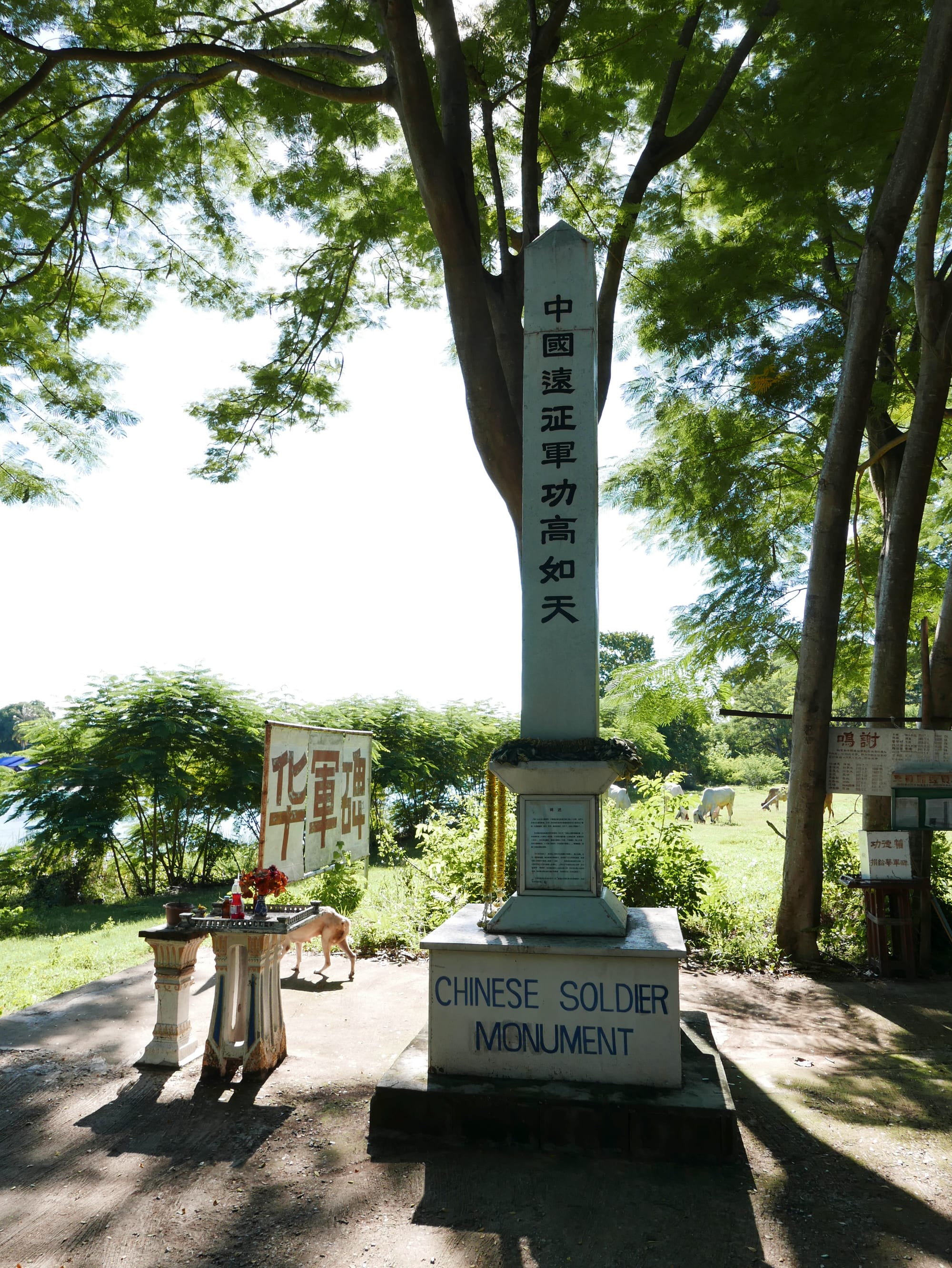
At the monument, I found some information about the memorial (the full text is at the end).
The memorial commemorates the 100,000 plus Chinese Expeditionary Force soldiers killed, mainly in Burma (now Myanmar).
Some 30,000 Chinese Prisoners of War worked on “The Death Railway” and “The Bridge on the River Kwai (สะพานข้ามแม่น้ำแคว)”.
The information document then described one horrific incident at the bridge, where the Chinese prisoners were used as human shields on the bridge during an Allied bombing raid. This resulted in the death of 300 prisoners.
The memorial is the work of a Thai woman called Wannipha, who sold her house to have the monument built to commemorate the lives of the Chinese soldiers killed at the bridge and the construction of the railway.
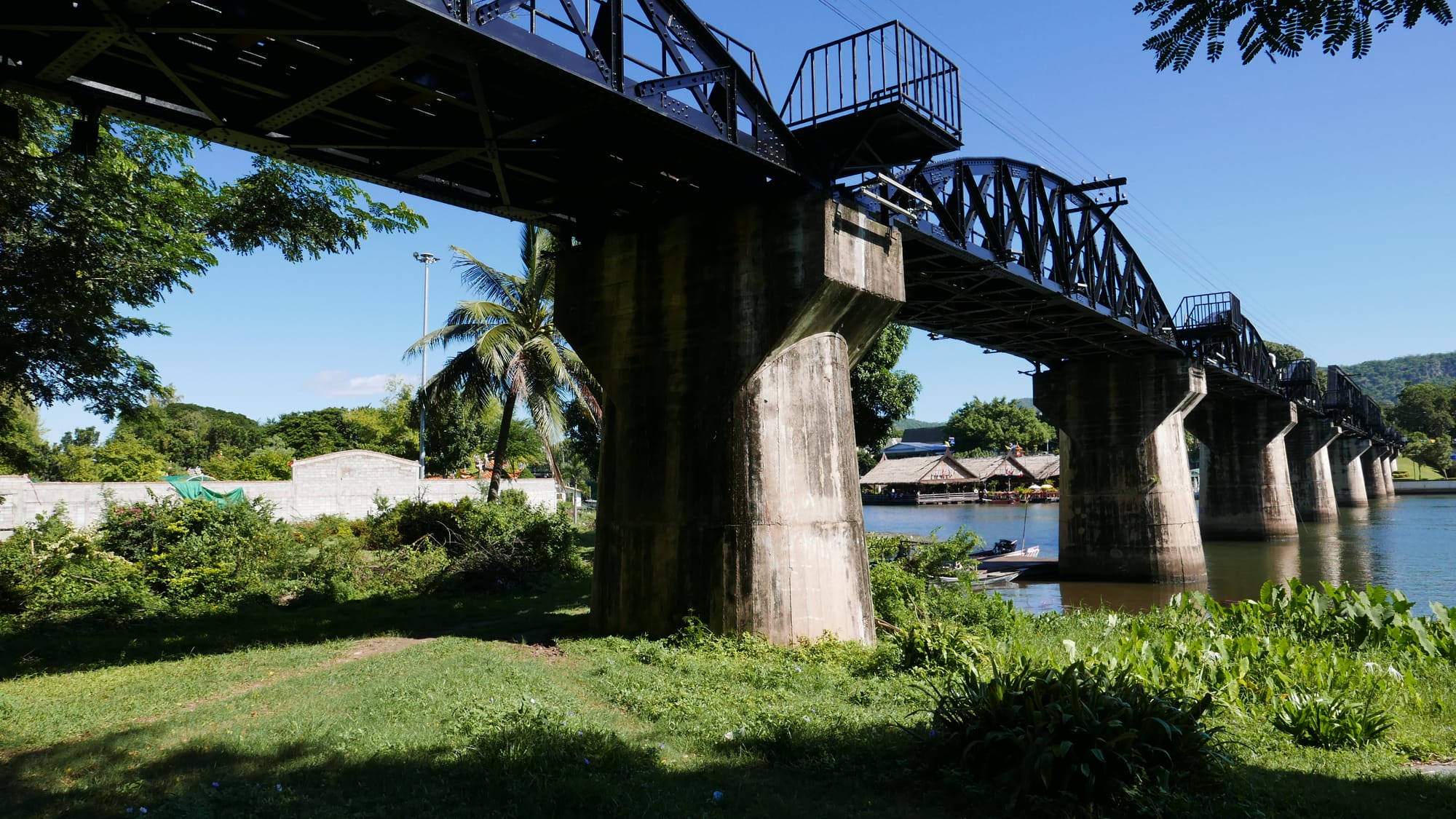
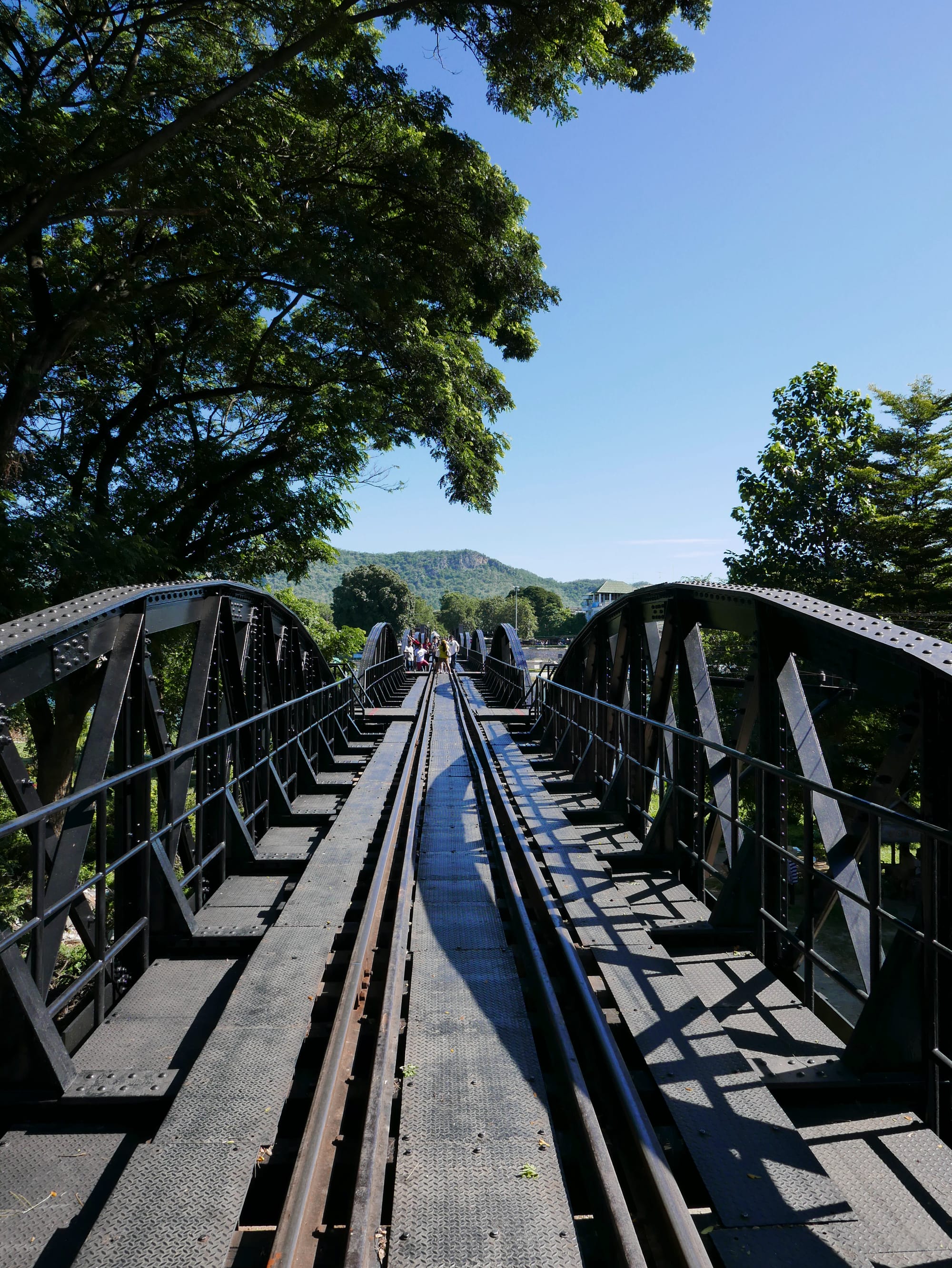
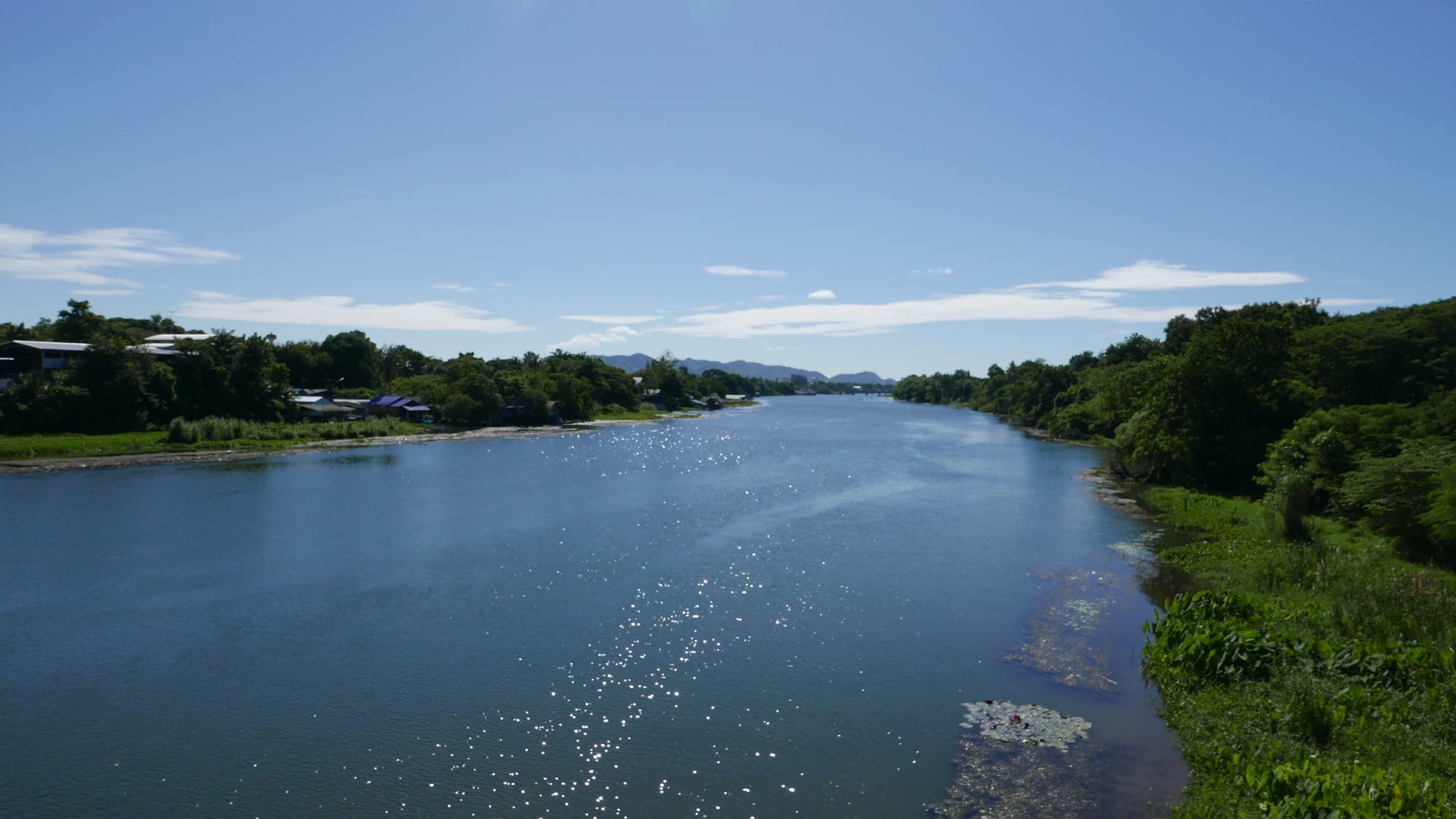
If you look at the photographs of the bridge, you may notice that some iron spans have a curved top and some a flat (see the photo below). Spans with a flat top are post-war replacements for spans damaged by Allied bombing.
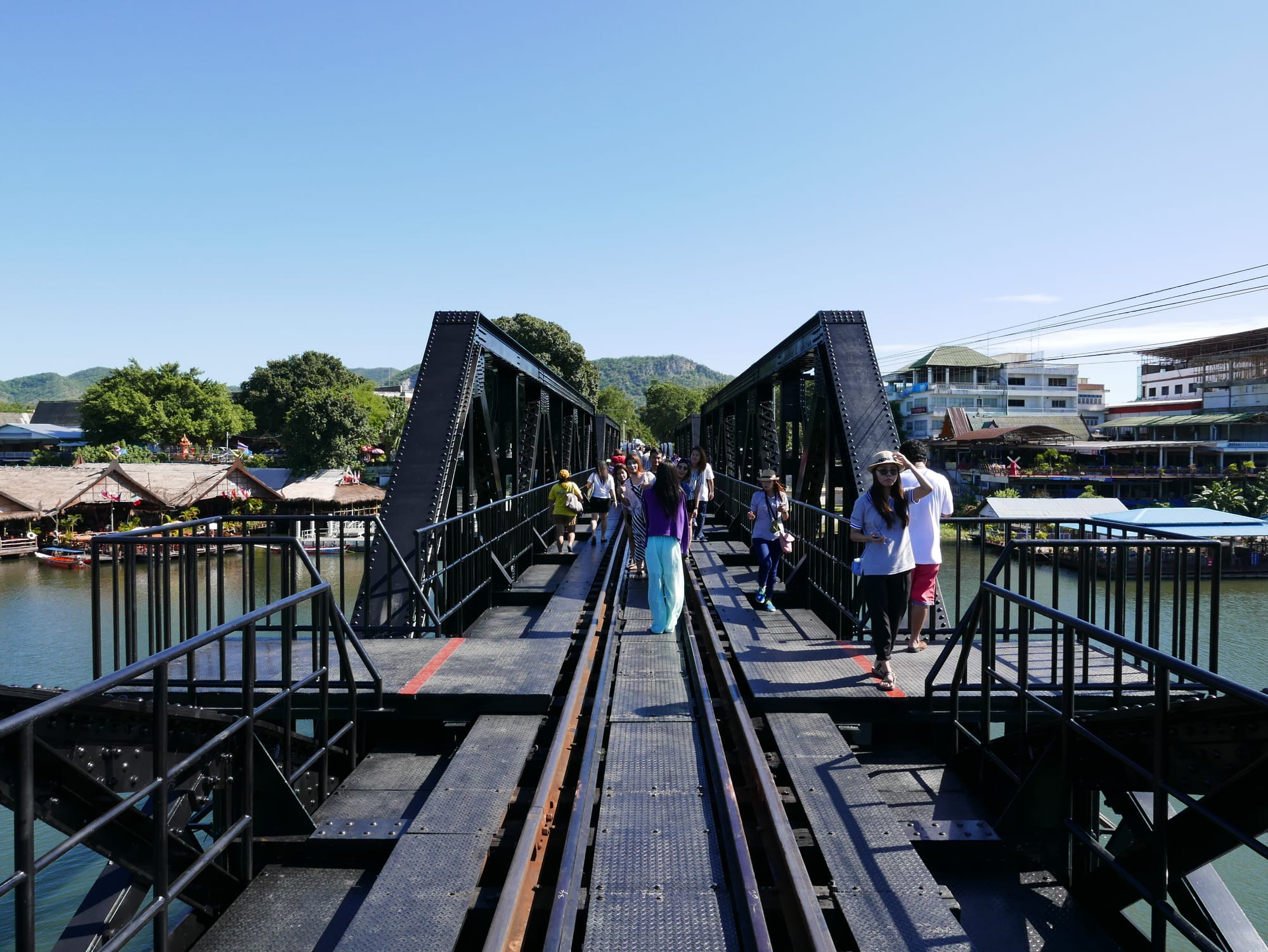
From the bank, it is still possible to view some damage to the concrete pillars, now patched, caused by the bombing.
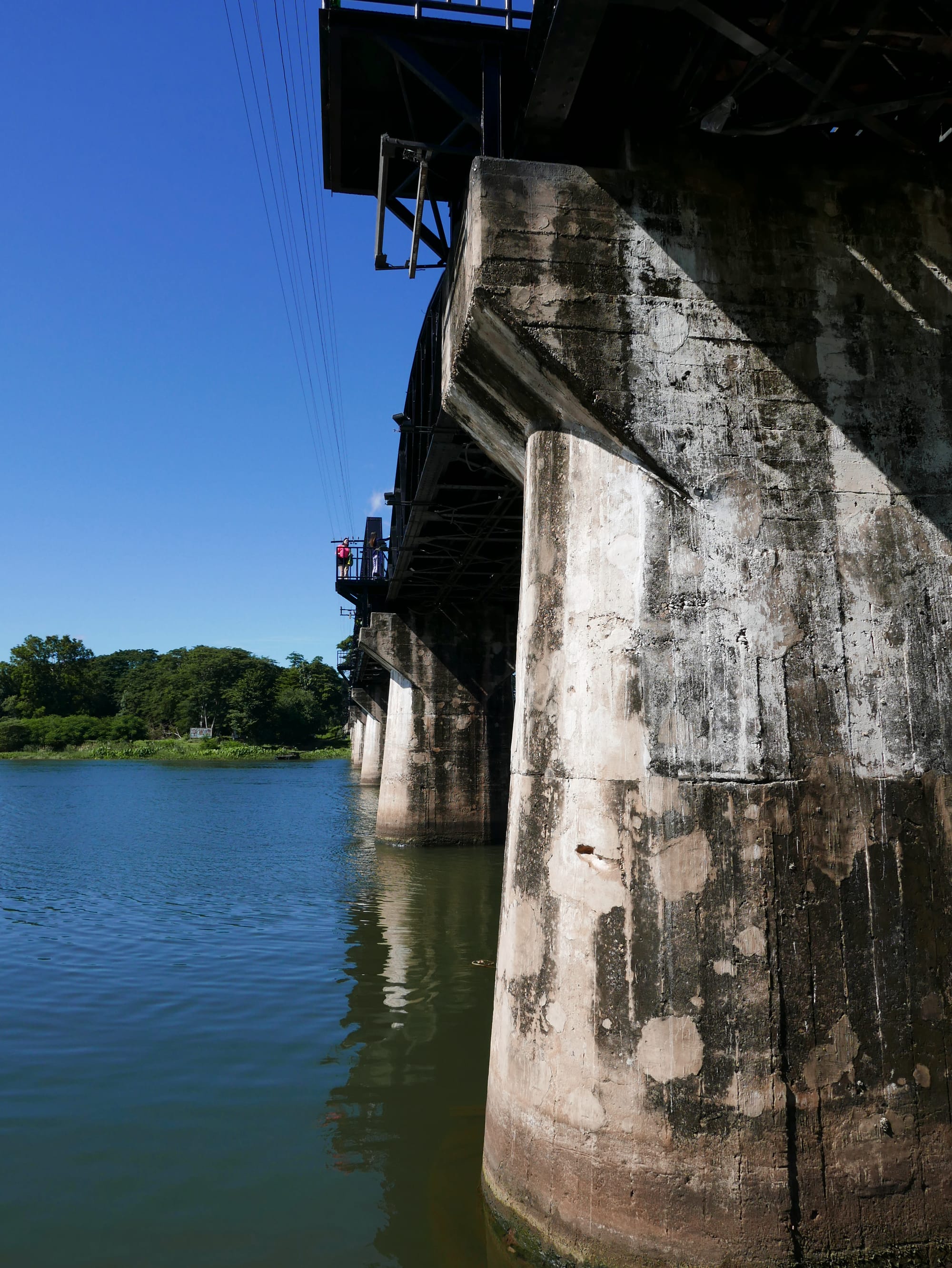
Near the bridge is a memorial to the American servicemen who died working on the bridge and railway.
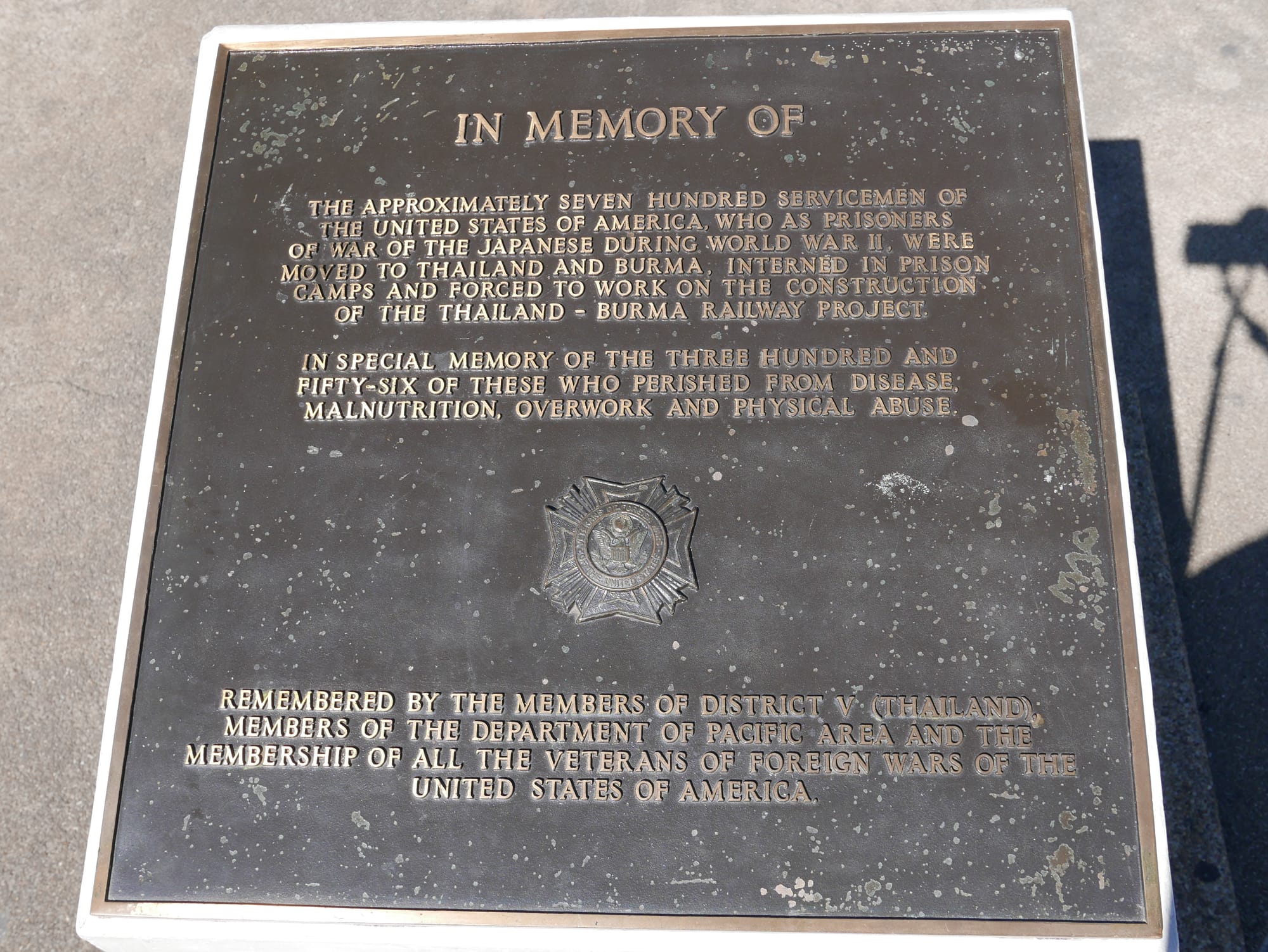
The memorial reads:
“In memory of the approximately seven hundred servicemen of the United States of America, who as prisoners of war of the Japanese during World War II, were moved to Thailand and Burma, interned in prison camps and forced to work on the construction of the Thailand - Burma Railway project.
In special memory of the three hundred and fifty-six of these who perished from disease, malnutrition, overwork and physical abuse.
Remembered by the members of District V (Thailand,) members of the Department of Pacific Area and the membership of all the veterans of foreign wars of the United States of America“
Nearby is another memorial commemorating 50 years of the railway and contains a raised relief map showing the railway route.
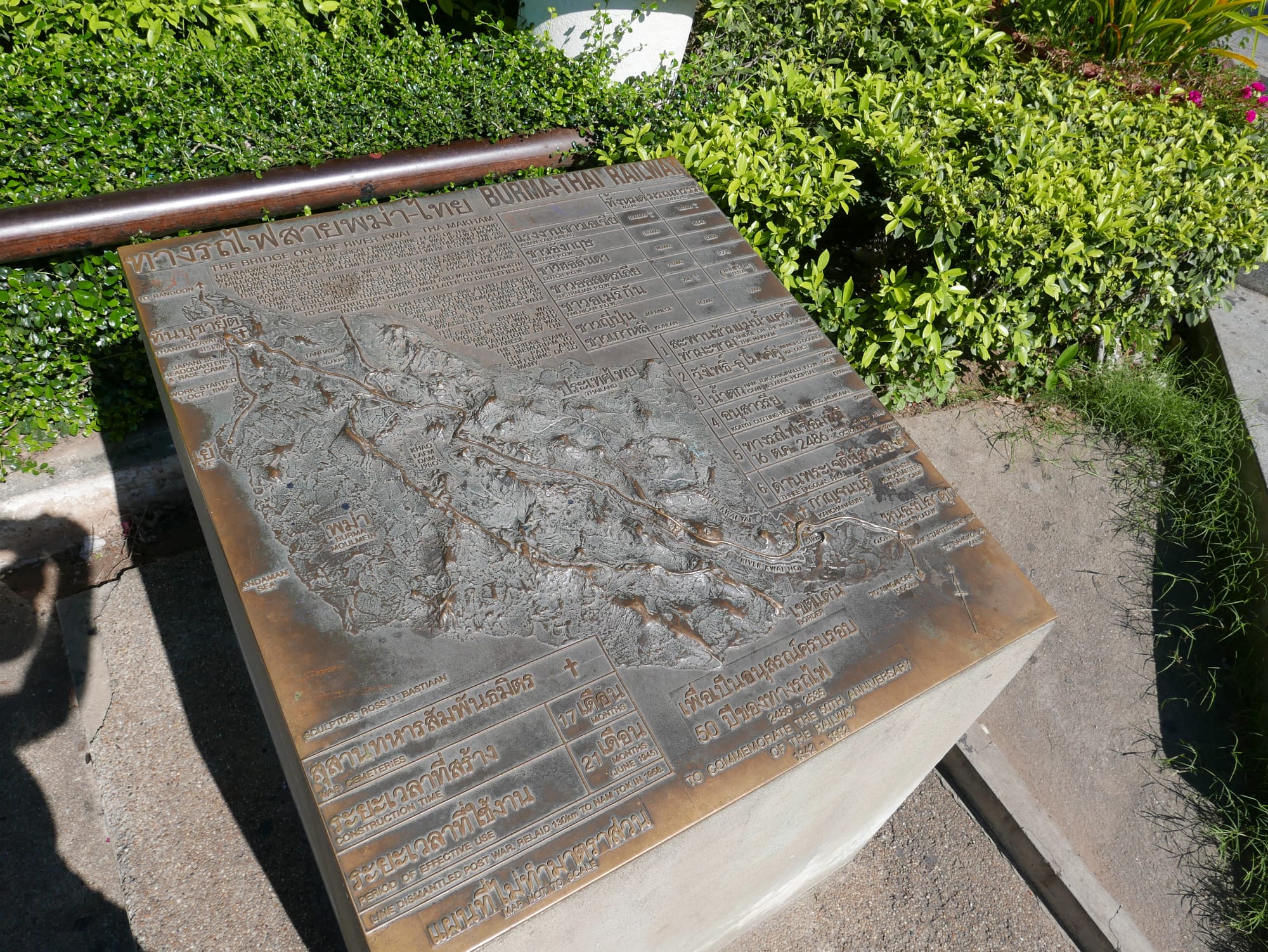
After exploring the bridge and surrounding area, I searched for the wooden bridge’s site. The wooden bridge was built to help build the railway bridge and was later demolished; it is near the railway bridge, down a small lane to the river.
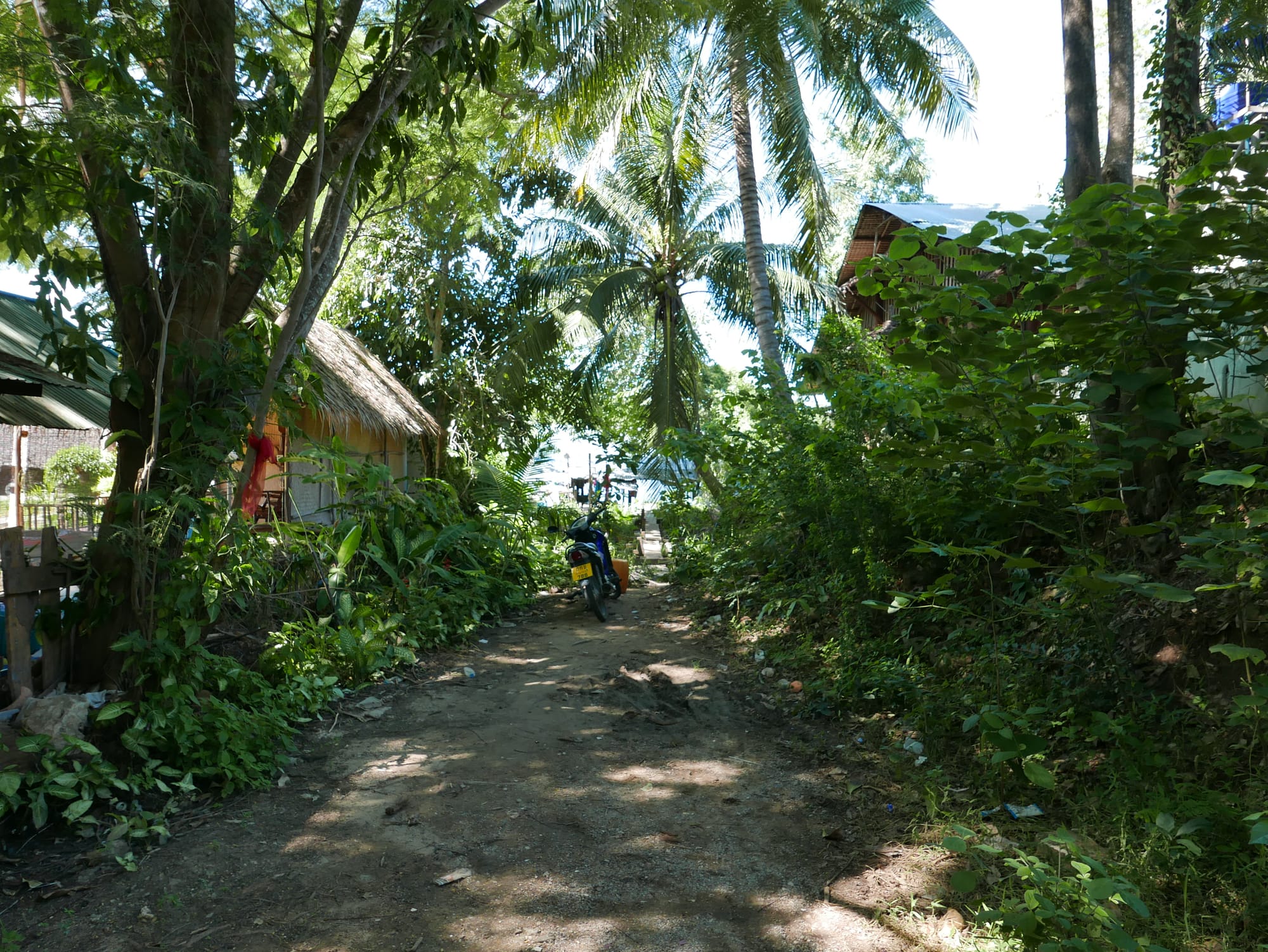
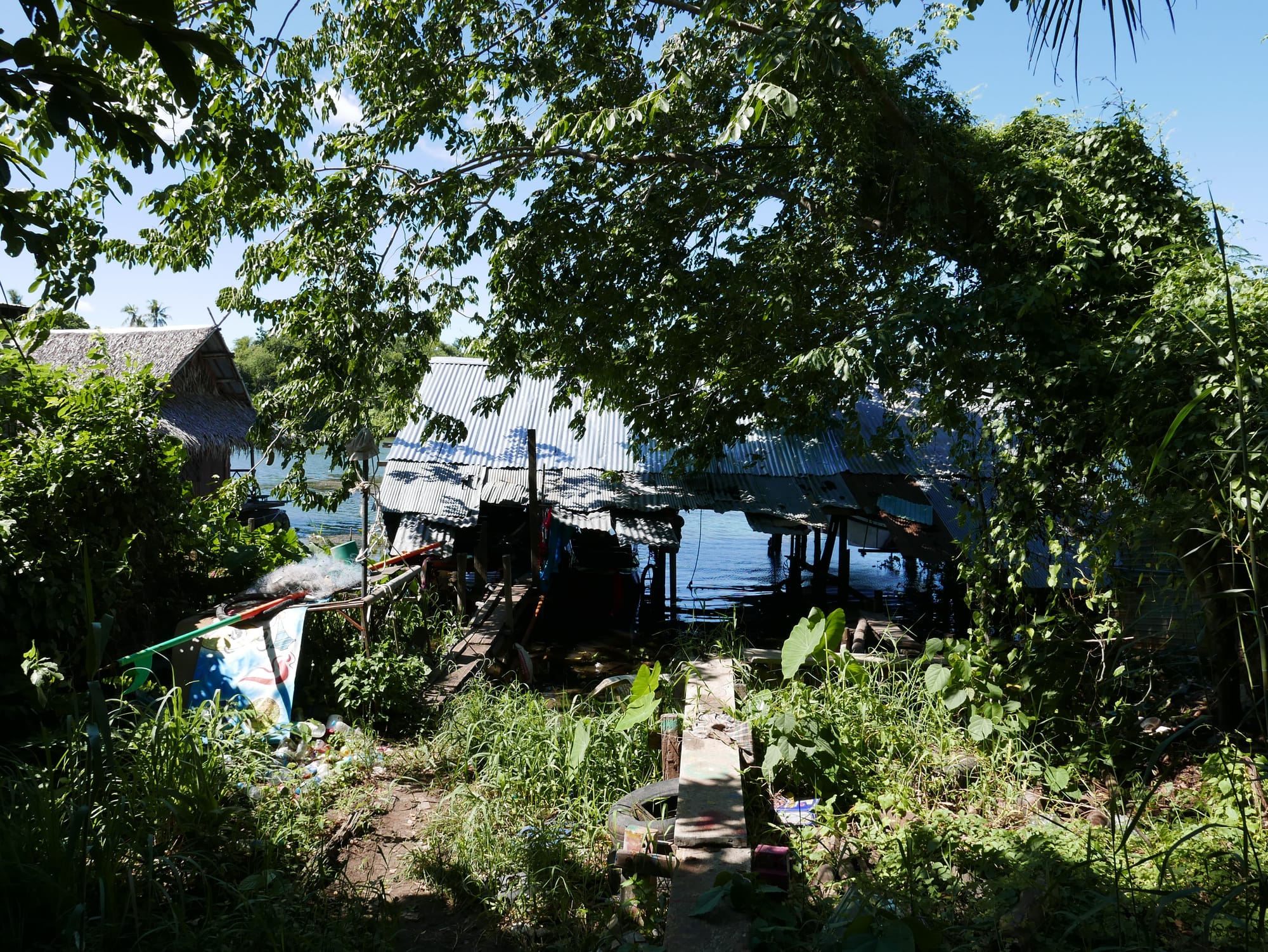
I found my visit to The Bridge on the River Kwai (สะพานข้ามแม่น้ำแคว) fascinating. As I stood there, looking at the bridge and the railway, it was hard to imagine the hardships the prisoners of war experienced in building the bridge and the railway.
Today, the scene looks peaceful and calm. It is beautiful. But during the Second World War, it must have been the equivalent of hell on Earth.
Foursquare: The Bridge of the River Kwai
Information plaques at the bridge
“The bridge over the River Kwae
The bridge over the River Kwae was built during the great Pacific War when Japan declared war on the United States of America and England, later became part of World War II. The bridge was begun in October, 2485 BE (1942 AD) and completed in October 2486 BE (1943 AD). On 16th September, 2485 BE (1942 AD) the Japanese army signed the contract with the Thai government to build the strategic railway from Thailand to Burma (now Myanmar). The railway started in Nonpladuk Station about 5 kilometres from Banpong Railway station, and crossed the River Kwae Yai at Ban Thamakham in Muang district of Kanchanaburi province. (in those days, the place was called “Ban Tha Maa Kham” meaning "horses crossing”.) The railway was laid northward passing through Kanchanaburi for about 4 kilometres along the River Kwae Yai, and at the bridge it made a sharp curve going along with the River Kwae Noi passing through the Thai-Burmese border at Three Pagodas Pass connecting the Burmese railway at Thanbyuzayat station. The total length of the railway was 415 kilometres: 303.95 kilometres in Thailand and 111.05 in Burmar. The prisoners of war taken from Malaya, Singapore, Indonesia, and other countries in the Pacific region were forced to build the railway. They were put on the train in the south and got off at Banpong station. They had to walk for 51 kilometres to get to Kanchanaburi. The prisoners of war, comprised of British, Australian, Dutch soldiers, as well as Malay, Chinese, Vietnamese, Indian, Burmese Javanese labourers totalling nearly two hundred thousand. The railway construction was very laborious and difficult as it had to go through thick, jungles, and high mountains, and dangerous animals were everywhere. The most difficult part was that they had to build the bridge over the River Kwae. The arduous task continued all days all night amidst hunger and dangerous diseases like malaria. The brutality of the war took over 100,000 lives of prisoners of war and labourers. Hence, the railway was called "The Death Railway.”
The Japanese army chose to build a bridge at Thanakham because the soil structure was solid and suitable. To speed up the work, the Japanese army built a temporary wooden bridge about 100 metres from the present one to transport construction materials. It took three months to complete. The present iron bridge spans were brought from Indonesia. The 300 meter bridge consisted of 11 iron spans and other parts were made of wood. The total construction time was only six months, and the total distance was 415 kilometres. The official opening date for the railway was the 28th November, 2486 BE (1943 AD). The wooden bridge was later dismantled as it blocked the waterway. During the war, the Bridge over the river Kwae was heavily bombarded by Allied planes. The spans 4–6 were damaged and unable to operate. Finally, Japan, surrendered on 15th August 2488 BE (1945 AD). After the war was over, the British government sold the railway and all railway related materials to the Thai government at the price of 50 million baht. Later, the State Railway of Thailand repaired bridge and replaced it with two iron spans and the 6 wooden parts were replaced by iron spans as well. The bridge has been in use to the present time.”
And:
“The most famous bridge – made famous by a postwar movie of the same name – was The Bridge over the river Kwai. There were, in fact, two bridges over ‘River Kwai’, built over the Mae Kong River at Tamarkan, several kilometres upstream from its meeting point with Kwae Noi River.
A wooden bridge across the Mae Kong was begun in August 1942. Designed to allow light diesel rail trucks to cross the river with construction materials, it was substantially completed by December, then swept away by floodwaters. Using much of the original material, it was quickly rebuilt and in operation again by January 1943.
While the first bridge was being built, a second, more substantial structure would begun. This bridge incorporated 11 semi-circular steel spans supported on concrete piers. Together with wooden approach spans, the bridge was 378 metres in length. It was completed in May 1943.
Incredibly, only nine prisoners of war were killed in accidents during the construction work of the Mae Kong. Much of the credit for this can be attributed to the sensible and courageous leadership of the work camp’s, British commanding officer, Lieutenant Colonel Philip Toosey”
Information at the China Expeditionary Force monument
“During the world war Il, there were more than 100,000 Chinese expeditionary force officers and soldiers were killed. Most of them died in Burma's battle field. But over 30,000 persons of war was escorted to Thailand to build the River Kwai Bridge and the Death Railway. They die here, Because of hunger, disease, tired and killed. All dead, and Also has been forgotten.
The opposite bank war museum kept such words, It read To stop the allied aircraft fried the bridge, Japanese troops forced the prisoners of war stood on the bridge as the flesh of man defence it. Allied bombers done know the situation, Intensive boom be had killed about 300 people by once. The river turned red at once, hundreds of corpses sunk into the river bottom. Can not drift, nobody salvaged, the river become fetid. For a long time no one dare to drink the water. The death were Chinese soldiers" Only a few words, it described how sanguinary the scene was.
Over sixty years, those Chinese soldiers who died for the human peace, without manned memorial. However, a Thai women with nameless, who sold his house and built stone ceremony for those Chinese soldiers. The tombstone like a sword rising into the sky, Set in the crater which three hundred soldiers had been killed. People called it "China Expeditionary Force monument" or "Lonely Army tablet" or "Chinese army tablet? But it really was the friendship tablet of Chinese and Thai, the sympathy tablet of anti-war people around the world. Afterwards, the woman began to built "the Lonely Army tomb "But finally, she died of poor, sickness and overwork.
Chinese people and all the people who love peace all over the world, will remember this kindness Thai lady. Her name is Wannipha.”
